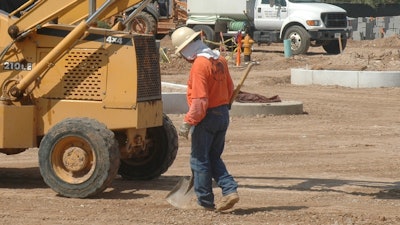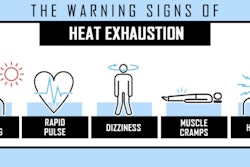
Between 1992 and 2016, 285 construction workers died from heat-related illnesses (HRIs), more than a third of all U.S. occupational fatalities due to heat-related causes, the National Institute for Occupational Safety and Health (NIOSH) points out in a recently issued report. It adds that this number may be underreported due to misclassification. This trend continues to rise along with average summer temperatures.
The fact that construction workers are at particular risk or HRIs is certainly not surprising. As the report authors point out, construction work is frequently labor intensive, which can cause the body to generate added heat. Combine this with work outdoors during the hottest times of year; indoors in non-climate-controlled spaces; or with heat-generating tools or materials (e.g., welding equipment, hot asphalt) and it can be an especially risky combination.
While most HRIs don’t result in deaths, they can have a significant impact on safety and productivity. As the report notes, “Injuries to construction workers on hot job sites can occur from impaired thinking; dizziness; sweaty, slippery hands; slowed response time; muscle fatigue and cramping; and clouded eyewear that blocks vision.” Even if injuries don’t occur, workers impacted by HRIs will be slower and less efficient, and mistakes on projects are more likely to occur – which could place profits, and other workers, at risk.
Prevention Measures to Beat the Heat
According to the report authors, the following should be considered by employers and EHS professionals when taking steps to protect construction workers from the adverse health effects of working in the heat:
- engineering and work practice controls
- training and acclimatization (allowing the body to gradually adjust to the heat)
- measuring and assessing heat stress
- medical monitoring and heat-protective clothing and personal protective equipment (PPE)
In addition, key prevention measures include:
- Assessing the risk, including determining exposure level and limits and screening workers for heat intolerance
- Limiting exposure by encouraging regular rest breaks, wearing of light-colored, loose-fitting, breathable clothing, scheduling hot jobs for cooler parts of the day, etc.
- Reducing the metabolic heat load – in other words, finding ways to reduce the amount of workload per worker during peak heat through increased mechanization of parts of the job, larger crew sizes, reduced work time and/or completing portions of the work in a temperature-controlled environment
- Enhancing heat tolerance by acclimatizing workers and carefully monitoring them as they adjust
- Encouraging hydration and ensuring adequate fluid supplies are available
- Creating a heat alert program, including training everyone on proper steps on excessive heat days and having procedures to deal with heat alerts, such as postponing non-urgent work, monitoring heat on site, etc.
- Knowing the symptoms of HRIs and making sure employees recognize and can take the proper steps to minimize their own risk and recognize risks in others
Following the steps above can help ensure that workers remain safe while working in hot environments. For further details and guidelines, click here to read the full NIOSH report.




















